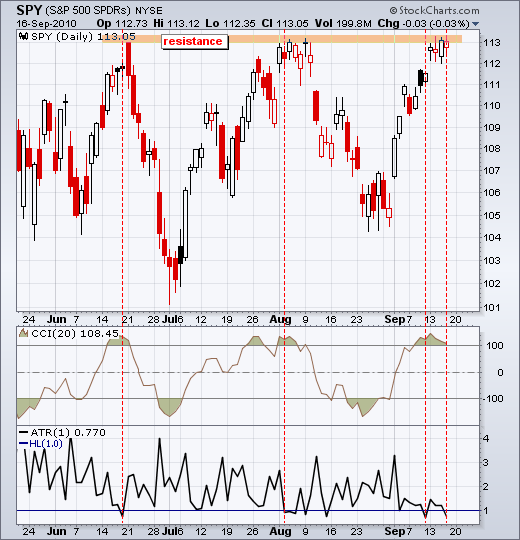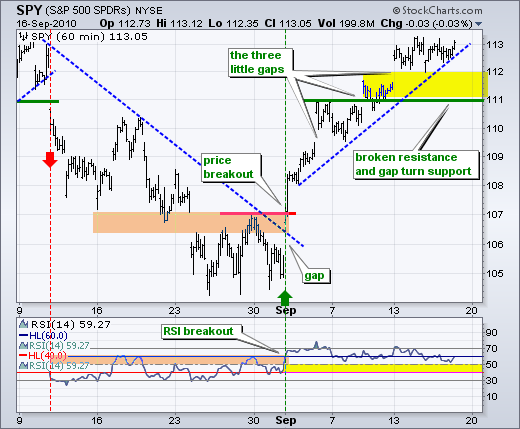Trading is getting a bit strange, but the bulls clearly have the edge in the stock market right now. Techs have started to lead on the upside, but small-caps were relatively weak as IWM closed down on Thursday. Even though stocks continue to move higher, oil took a rather hard spill over the last three days (down 3-4%). On the bullish side, the Euro continues to rise, the Dollar has fallen sharply this week and bonds are moving lower. Movements in these three suggest that the risk-on trade remains alive and well.


Again, there is not much change on the daily chart as SPY flirts with resistance. As in early August, SPY is churning in the 112-113 area. Notice that the ETF formed numerous white candlesticks in early August and has now formed four white candlesticks this week. Only one is long enough to show any buying pressure. The other three show indecision. Yesterday's high-low range produced another low Average True Range (ATR) reading, the second in as many weeks. As noted earlier this week, the combination of overbought conditions and a narrow range day foreshadowed reversals in mid July and early August. However, I have a gut feel that the bulls are going to produce a resistance breakout before we see a reversal this time. Monday's gap is the area to watch. A move below 110.8 would reverse the September upswing. And what an upswing it has been.

There is no change on the 60-minute chart. Support is based on broken resistance around 111, the little consolidation and Monday's gap. The early August stall traded in a 2 point range (111 to 113). Therefore, I would like to give the market a little wiggle room. With performance anxiety eating at portfolio managers, little dips may be enough to entice the bulls. The trick is to identify a dip big enough to result in an actual trend reversal. A move below 110.8 in SPY and 40 in RSI would be enough to reverse this short-term uptrend.

Key Economic Reports:
Fri - Sep 17 - 08:30 - CPI
Fri - Sep 17 - 09:55 - Michigan Sentiment
Charts of Interest: Tuesday and Thursday.
This commentary and charts-of-interest are designed to stimulate thinking. This analysis is not a recommendation to buy, sell, hold or sell short any security (stock ETF or otherwise). We all need to think for ourselves when it comes to trading our own accounts. First, it is the only way to really learn. Second, we are the only ones responsible for our decisions. Think of these charts as food for further analysis. Before making a trade, it is important to have a plan. Plan the trade and trade the plan. Among other things, this includes setting a trigger level, a target area and a stop-loss level. It is also important to plan for three possible price movements: advance, decline or sideways. Have a plan for all three scenarios BEFORE making the trade. Consider possible holding times. And finally, look at overall market conditions and sector/industry performance.

About the author:
Arthur Hill, CMT, is the Chief Technical Strategist at TrendInvestorPro.com. Focusing predominantly on US equities and ETFs, his systematic approach of identifying trend, finding signals within the trend, and setting key price levels has made him an esteemed market technician. Arthur has written articles for numerous financial publications including Barrons and Stocks & Commodities Magazine. In addition to his Chartered Market Technician (CMT) designation, he holds an MBA from the Cass Business School at City University in London.
Learn More





